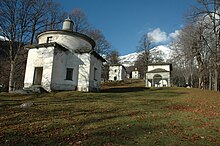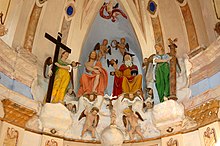Acalvary, also called calvary hill, Sacred Mount, or Sacred Mountain, is a type of Christian sacred place, built on the slopes of a hill, composed by a set of chapels, usually laid out in the form of a pilgrims' way. It is intended to represent the passionofJesus Christ and takes its name after Calvary, the hill in Jerusalem where Jesus was crucified.








These function as greatly expanded versions of the Stations of the Cross that are usual in Catholic churches, allowing the devout to follow the progress of the stages of the Passion of Christ along the Via DolorosainJerusalem. Each chapel contains a large image of the scene from the Passion it commemorates, sometimes in sculpture, that may be up to life-size. This kind of shrine was especially popular in the Baroque period when the Holy Land was under Ottoman Turkish rule and it was dangerous and highly difficult to make a pilgrimage to the Church of the Holy Sepulchre in Jerusalem.
Calvaries were especially popular with the Franciscan and Jesuit orders, and are most common in Italy, the Catholic regions of Germany, and Habsburg-ruled Central Europe. They were usually placed in parks near a church or a monastery, typically on a hill which the visitor gradually ascends. Italian ones are usually called a sacro monte ("holy mountain" or "hill"); there are a group of nine Sacri Monti of Piedmont and Lombardy that are especially notable; their dates of foundation vary between 1486 and 1712. Devotions would be most popular in Passion Week, before Easter, when large processions around the stations would be held, and mystery plays might also be acted. If a calvary was established in an inhabited place, it might result in a location of a new village or town. Several villages and towns are named after such a complex.[citation needed]
The Mount of Calvary was the site outside the gates of Jerusalem where the crucifixion of Christ took place. The scene was replicated around the world in numerous "calvary hills" after the Counter-Reformation and they are used by Roman Catholics in particular as part of their worship and veneration of God.
The term is derived from St Jerome's Ecclesiastical Latin translation in the Vulgate of the Aramaic name for original hill, Golgotha, where it is termed calvariae locus "the place of the skull".[1][2] Martin Luther translated Golgatha as "skull place" (Scheddelstet). This translation is debated; at the very least it is not clear whether it referred to the shape of the hill, its use as a place of execution or burial or refers to something else.[3]
"Calvary hill" today refers to a roughly life-size depiction of the scenes of the Passion of Christ, with sculptures of additional figures. These scenes are set up on the slopes of a hill. The traditional fourteen stations of the cross are usually laid out on the way up to the top of the pilgrimage hill and there is often a small, remote churchorchapel located between a few dozen to several hundred metres away.
Calvary hills must not be confused with calvaries, which are a specific type of wayside monumental crucifix, a tradition mostly found in Brittany especially in the Finistère, built in parish closes between 1450 and the 17th century.
Mount St Bernard Abbey, Leicestershire.
German:
French: